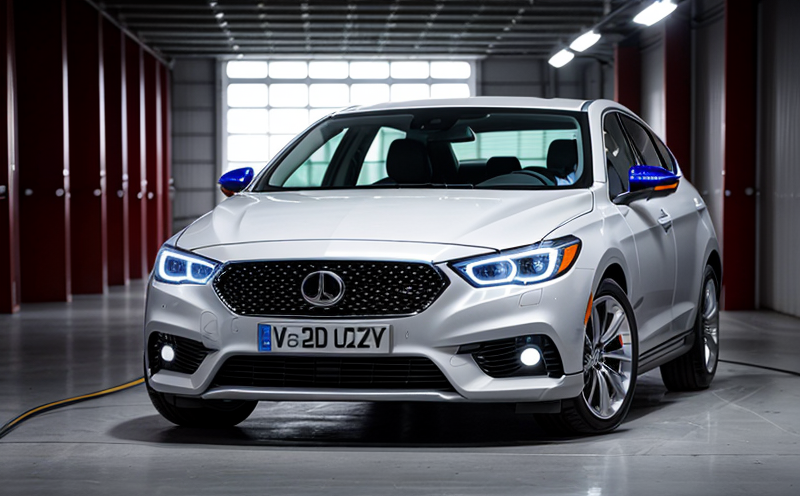ECE R148 LED Lamp Testing for Motor Vehicles
The ECE R148 regulation is a globally recognized standard that governs the technical requirements and testing procedures for automotive lighting devices. This regulation ensures the safety, performance, and interchangeability of vehicle lamps across Europe and beyond, including countries that have adopted this normative framework.
For LED lamps used in motor vehicles, compliance with ECE R148 is essential to ensure that these lights meet stringent international standards for brightness, color temperature, optical distribution, and other critical parameters. The testing process involves a series of laboratory-based evaluations aimed at verifying the functional integrity and safety of the lamp before it can be approved for use in automotive applications.
The testing procedure typically starts with a thorough inspection and dimensional measurement to ensure that the physical attributes of the LED lamp align with specified dimensions as per ECE R148. Following this, rigorous optical performance tests are conducted using specialized equipment like photometers and integrating spheres to measure luminaire efficiency and color rendering index (CRI). Heat dissipation tests assess how effectively the lamp dissipates heat to prevent overheating which could lead to failure or malfunction.
Environmental stress testing is another crucial aspect where lamps undergo exposure to extreme conditions such as high temperatures, humidity, and vibration to simulate real-world driving environments. These tests help identify potential weaknesses that might not be apparent under normal laboratory conditions. Additionally, electrical safety assessments ensure that the LED lamp complies with all relevant electrical standards to prevent short circuits or other hazards.
After completing these comprehensive tests, detailed reports are generated summarizing each test result against specified criteria outlined in ECE R148. These reports serve as proof of compliance and are often required by regulatory bodies before a product can be officially approved for sale within the specified markets.
The significance of accurate testing cannot be overstated; it ensures that automotive lighting systems perform reliably under various operating conditions, contributing to enhanced road safety and reduced incidents due to poor visibility or malfunctioning lights. Compliance with ECE R148 not only supports manufacturers in meeting regulatory requirements but also enhances brand reputation by demonstrating commitment to quality and safety standards.
Given the complexity of modern LED technology within automotive lighting systems, adherence to rigorous testing protocols like those mandated by ECE R148 is indispensable. By meticulously evaluating every component of an LED lamp’s design and performance, laboratories specializing in this field play a pivotal role in upholding global standards for road safety.
Benefits
- Enhanced Safety: Ensures that automotive lighting meets strict international standards, reducing the risk of accidents due to poor visibility or malfunctioning lights.
- Compliance Assurance: Provides clear evidence that products meet regulatory requirements, facilitating smoother market entry into Europe and other regions adopting ECE R148 norms.
- Quality Control: Identifies potential issues early in the development process through comprehensive testing, allowing for necessary adjustments before final production runs.
- Brand Reputation: Demonstrates a commitment to quality and safety standards, enhancing brand image among consumers who prioritize reliability and performance.
Industry Applications
- Vehicles: Ensures the lamps used in cars, motorcycles, trucks, buses, and other motor vehicles meet stringent international standards for brightness, color temperature, and optical distribution.
- Lighting Manufacturers: Provides a reliable testing service to ensure that newly developed LED lamps comply with ECE R148 specifications before they are introduced into the market.
International Acceptance and Recognition
The ECE R148 regulation has gained widespread acceptance internationally, particularly in Europe but also extending to other regions that recognize this standard. Its global recognition stems from its comprehensive approach towards ensuring the safety and performance of automotive lighting systems.
Many countries have adopted or are in the process of adopting the ECE R148 framework because it provides a harmonized set of rules that simplify compliance for manufacturers operating across multiple jurisdictions. By adhering to these standards, companies can streamline their certification processes, reducing costs and time-to-market.
Automotive manufacturers rely heavily on testing facilities certified according to ECE R148 guidelines to ensure consistency in product quality across different regions. This harmonization not only benefits the industry by fostering innovation but also contributes significantly towards enhancing road safety globally. The consistent application of these standards ensures that consumers can trust that any vehicle they purchase will meet essential safety requirements regardless of where it was manufactured or sold.





